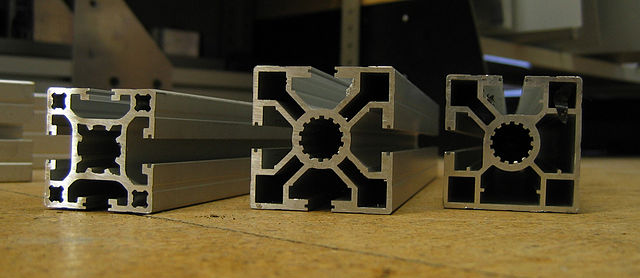Loading AI tools
Framing system made of extruded aluminum From Wikipedia, the free encyclopedia
T-slot structural framing is a framing system consisting of lengths of square or rectangular extruded aluminium, typically 6105-T5 aluminium alloy, with a T-slot down the centerline of one or more sides.
This article needs additional citations for verification. (April 2022) |




It is also known under several generic names, such as aluminium extrusion, aluminium profile and 2020 extrusion if the cross-section is 20x20 mm, alongside brand names, such as 80/20 framing.[1]
While the precise history of the T-slot framing system is not known, advancement in extrusion press technology in the early 1950s allowed for economic production of aluminium profiles,[2] and examples of use can be found from the early 1960s.[3]
Although no published standard defines the system, it is produced in a series of conventional sizes which allows for compatibility between manufacturers.
There is a variation on T-slot profiles known as V-slot rails where V-slot wheels are slotted into the V-shaped channels of the framing for linear motion in a 3D printer or other CNC machine.
T-slot framing is divided into metric and fractional (imperial) categories. The T-slot is always centered along the long-axis of the piece. Pieces are available in each series with a square cross-section. Rectangular cross sections are also available which measure x by 2x (where x is the defined width) - e.g. 40mm by 80mm for 40 series.
| Profile type |
Profile name |
Profile size |
|---|---|---|
| fractional | 10 series | 1" |
| 15 series | 1.5" | |
| metric | 20 series | 20 mm |
| 25 series | 25 mm | |
| 30 series | 30 mm | |
| 40 series | 40 mm | |
| 45 series | 45 mm |
Seamless Wikipedia browsing. On steroids.
Every time you click a link to Wikipedia, Wiktionary or Wikiquote in your browser's search results, it will show the modern Wikiwand interface.
Wikiwand extension is a five stars, simple, with minimum permission required to keep your browsing private, safe and transparent.